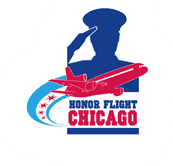Air Force Vietnam War Flight date: 05/14/25
By Joe Kolina, Honor Flight Chicago Veteran Interview Volunteer
The words came slowly, spoken with deep feeling. I had asked Major Patricia Knight (USAF retired) to reflect on her distinguished 21 years of service in the United States Air Force. Tears welled up in her eyes as she searched for words.
“I served my country and I would do it over in a heartbeat,” she began. “If the Air Force wanted me today I’d go without hesitation.”
But she had a regret, too. Major Knight wished the Air Force had allowed her to do even more.
We were sitting at a table in Cantigny Park in Wheaton. Lawns of freshly-cut grass glittered through the windows. Row after row of flowers with bright yellow petals stood tall, like soldiers at attention. Water from a fountain gushed into the air. The famous First Division Museum and Tank Park spread out under a grove of trees.
“I’m forever disappointed that I couldn’t serve my country totally,” she said. “To me, serving my country is giving me the opportunity to give my life for my country. And others decided I wouldn’t be allowed to do that, so I couldn’t go into combat.”
Nonetheless, Major Knight created a trailblazing record of achievement and excellence in computer science and teaching. It culminated in the Defense Department awarding her its Defense Meritorious Service Medal.
It’s a story that began—seemingly—by accident. But it was just the first instance in a lifelong pattern in which people and places and choices circled back to reappear and play a big role in her life.
Patricia Dalman grew up in sleepy Lemont, Illinois. She never thought about the Air Force growing up. She recalled that her mom and dad gave her plastic airplane models to assemble. She loved going with her dad to the air shows on the military side of O’Hare Airport. And she participated in the Civil Aviation Patrol squadron at Lemont High School.
But everyone thought Pat was destined to become a schoolteacher. So did she. Then, two years into studying math at North Central College she came face-to-face with a serious problem.
“I wasn’t happy,” she recalled. “I didn’t know what I was doing or where I was going. I was doing okay in school but I just wasn’t into it.”
Her mother finally came up with the idea that changed her life.

“Both my mother and father had been in the Army in World War II,” she said. “And one day I guess my mother got tired of my tears and unhappiness and said, ‘Why don’t you go into the military?’”
Pat’s lifelong interest in airplanes and high school experience in the Civil Air Patrol were one of those circles that made the Air Force a natural choice. So was her interest in math.
“I love math and wanted to be in a technical area of math,” she explained. “But there wasn’t STEM like there is now. I saw the Air Force as being wide open, where I could do things and go places and get other opportunities where I could grow.”
Pat began basic training at Lackland Air Force Base in San Antonio in June of 1966.
“I thought it was great,” she remembered. “And I could go in with one stripe because of my Civil Air Patrol background. I was never happier.”
In those days, women had three choices after basic training: accounting, personnel or medical. Pat’s interests led to finance duty at Shepard Air Force Base at Wichita Falls and back at Lackland.
And then another one of those circles led to a new adventure. The Air Force needed computer science officers. So it gave Pat a chance to complete her college math degree.
“They sent me to Colorado State University,” she said. “I studied in the math department because there was no such thing as a computer science degree then. But I took computer science courses because that’s what the Air Force wanted and needed.”
She earned her degree and her career trajectory soon took a detour. Pat returned to Lackland. She graduated from Officer Training School in 1971 and was sent to write computer programs at Fort Meade in Maryland, outside of Washington D.C. She supported the work of a top-secret agency. A civilian organization whose name she cannot divulge, even all this time later.
After two years, another of Pat’s circles rounded back to her. She heard that a higher-ranking woman officer she knew was looking for a candidate to command a squadron of women at Goodfellow Air Force Base in San Angelo, Texas.
More women entering the Air Force meant a greater need for leaders. Enlisted women were doing jobs they hadn’t performed before, like radio operators, Morse Code intercept operators, and linguists.
“I always dreamed of being a squadron commander, being in charge of a group of women, so I called and said, ‘Take me, take me, take me,’” Pat said.
She got the job, despite initial concern that her security clearance could complicate the transfer. She also used her off-duty time in San Angelo to earn aviation certifications. She eventually got them for airplanes, helicopters and gliders.
But first there were new orders, orders that led to a groundbreaking assignment. The Air Force sent Pat to the University of Illinois for 18 months to earn a Masters degree in computer science. In 1976, the Air Force Academy admitted its first class of women cadets. Pat got an unexpected call from a major at the academy.
“He said we’re starting to bring women into the Air Force Academy and we need to get women on the faculty. What do you say?” she remembers. “I thought for a moment and then, yeah, what was there to think about?”
So Pat became a teacher after all. She taught computer science at the Academy for six years. She still admires the grit and stamina of her students.
“I don’t think I could have done it,” she said. “Everything from morning till night was prescribed for them. Two hours of differential equations two times a week, and having to pass a test on it without much time to study. Please!”
Pat and her colleagues helped the first classes of women adjust to academy life, including occasional problems of discrimination.
“There were a lot of challenges,” she said. “You had to deal with it. We figured it out.”
She also called on her flight training to teach aviation, both in the classroom and flying gliders in a summer elective program. Pat’s time as a teacher and squadron leader were among the most satisfying of her Air Force career.
“It was rewarding to see people grow as they learned about computer science, and airplanes, how to be an officer, how to conduct themselves and do the job the Air Force wanted them to do,” she said.
A three-year stint leading a computer programming group at the Strategic Air Command in Omaha followed. And later she spent two years in Portugal helping to install a new command and control and surveillance computer system for NATO.
Pat had made the list for promotion to Lieutenant Colonel when she decided to retire in 1987. Looking back, she was especially grateful to two women who helped her reach her potential in the Air Force.
Colonel Norma Brown was her commanding officer at her first assignment in San Angelo.
“She was so cool, I mean nothing ever ruffled her feathers,” Pat remembered, an example of how an excellent commander acted. “I still have a lot of respect for her.”
Her other mentor was named Sonja Shipman. She was a second lieutenant when Pat first was assigned to Lackland Air Force Base. Lt. Shipman encouraged Pat to check out the program to finish college and qualify for Officer Training School. When Pat finally made OTS, Lt. Shipman was her commander, another one of those circles that Pat so often noticed in her life.
“She reached out to me,” Pat says. “She saw something in me, saw that I could be an officer and a leader. She had a way of encouraging me. And I know I’ve incorporated that into what I do even now to encourage students and others.”
The circles kept going around and around for Pat. She has spent her retirement in airplanes and classrooms. She still teaches community college classes. She worked for the FAA doing accident investigations and rules compliance. And Pat was a corporate and commercial aviation pilot for more than 30 years.
Flying became Pat’s passion. She couldn’t fly in the Air Force but she traveled all over the country and parts of the world as a pilot. Pat said she’s never been happier than behind the controls of a plane.
“It just had to be a part of my life,” she said. “The things I’ve seen. A triple rainbow. Looking over the tops of thunderstorms. Lightning arcing from one to another. I’ve seen tornadoes coming out of the sky. I got to see that stuff for real.”
Congratulations on this new honor, Pat.
Thank you for your service.


